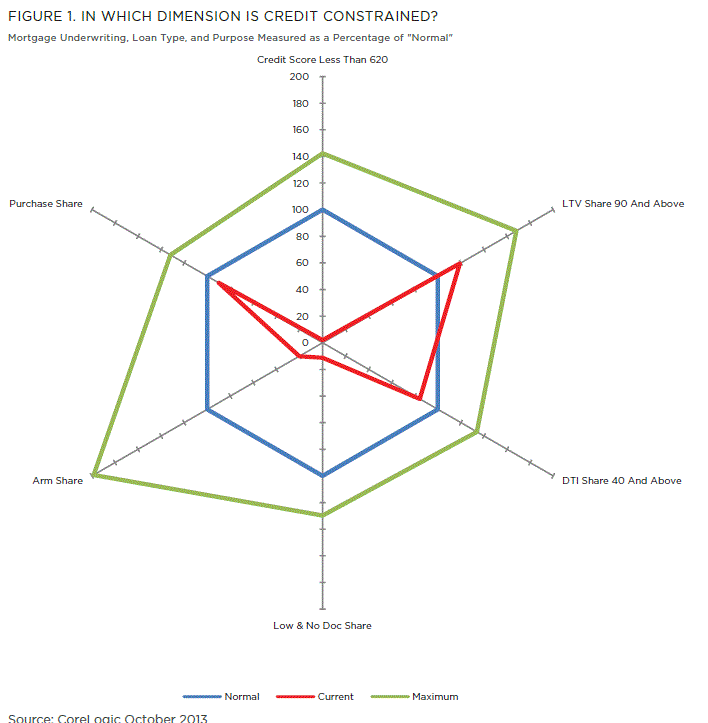Blog

CoreLogic Looks at Components of Mortgage Credit Availability
It is almost a given that the mortgagernmarket will be smaller this year than last so discussions have turned to thernavailability of mortgage credit and whether it is too tight. Mark Fleming, chief economist at CoreLogic, saysrnthat the question of availability has taken on more importance as the QualifiedrnMortgage (QM) standard is implemented and the industry has to determine the typesrnof credit it will offer to borrowers. Hernpresents a different take on the subject in the current issue of the company’s Marketpulse. rn</p
Whether credit is too tight or toornloose, he says, is an especially difficult question to answer because there isrnno single measure of its availability. Howeverrnthere are a variety of metrics that collectively influence that access; creditrnworthiness, loan-to-value and debt-to-income ratios, the level of documentation,rnthe availability of adjustable rate loans, and the share of purchase loans.</p
Fleming set out to measure the currentrnlimits on these measures by determining what constitutes a “normal” level ofrnavailability for each metric. To do thisrnhe settled on the year preceding an announcement by the Federal Reserve inrnFebruary 2004 encouraging the use of adjustable rate mortgages and its subsequentrnraising of the federal funds rate as baseline period for his demonstration andrnlooked at averages for the metrics during that period. For example, over that year the averagerncredit score for all first lien purchase loans was 710. In October 2013 it was 749. </p
While this is only a 5 percent difference,rnhe points out that the share of loans with credit scores below 620 was 29rnpercent over the baseline period and was 0.3 percent in October 2013. “It is much more insightful to compare thernshare of the riskiest subset of the entire measure’s distribution to that samernshare before the housing bubble,” he says. rn”Credit availability in each metric represents the extent to whichrnlenders originate loans to the riskier subset of the distribution.”</p
Fleming constructed the figure below withrneach axis representing a different measure of credit availability and the innerrn(blue) hexagon crossing each axis at the value of 100 which represents thernnormal value for that metric based on the average during the year preceding thernFed’s 2004 announcement. The outerrn(green) hexagon represents the deviation from normal at the loosest pointrnduring the housing bubble. Redrnrepresents the conditions in October 2013. </p
 http://www.corelogic.com/research/the-market-pulse/marketpulse_2014-january.pdf?WT.mc_id=prtm_140117_0GnWO</p
http://www.corelogic.com/research/the-market-pulse/marketpulse_2014-january.pdf?WT.mc_id=prtm_140117_0GnWO</p
Going back to the example of creditrnscores, the share of first lien purchase mortgages with scores below 620 was 29rnpercent during that year and that is indexed to 100. The October 2013 origination of mortgagesrnwith scores that low was virtually zero (0.3 percent). </p
Fleming says that what is immediatelyrnapparent is the credit availability is tight for two important underwritingrncriteria, credit scores and low documentation levels, neither of which arernbeing originated relative to either the height of the expansion of credit orrnthe normalized level of availability. rnUnderwriting eligibility in the current market requires both good creditrnand the ability to fully document loans. rnHowever the shares of high LTV and high-DTI lender are currently closernto normal. Both had expanded availabilityrnduring the housing boom and high LTV lending remains modestly loose relative tornnormal while high DTI lending is modestly tight. ARM loans are much more restricted thanrnnormal “as many subprime ARM loan products are no longer available.”</p
Fleming says that looking at thernriskiest subset of an entire measure’s distribution and comparing it to thernshare in a more typical time gives more insight into whether credit is toornloose or too tight. Currently credit isrntight for low credit score borrowers, those who can’t or don’t want to documentrntheir loans, and those who want an ARM product. rn”For many, the choice to document or select an ARM product is not necessarilyrnan impediment to credit availability,” he says. rn”However, for those with low credit scores there are fewer options.”
All Content Copyright © 2003 – 2009 Brown House Media, Inc. All Rights Reserved.nReproduction in any form without permission of MortgageNewsDaily.com is prohibited.
Latest Articles
By John Gittelsohn August 24, 2020, 4:00 AM PDT Some of the largest real estate investors are walking away from Read More...
Late-Stage Delinquencies are SurgingAug 21 2020, 11:59AM Like the report from Black Knight earlier today, the second quarter National Delinquency Survey from the Read More...
Published by the Federal Reserve Bank of San FranciscoIt was recently published by the Federal Reserve Bank of San Francisco, which is about as official as you can Read More...

Comments
Leave a Comment